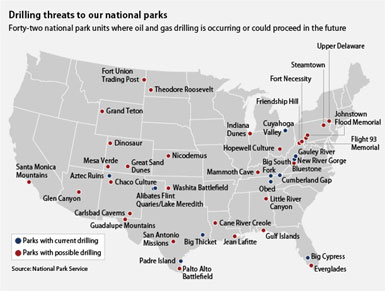The Department of Interior (DOI) released revised regulations for fracking on public and Native American lands today, leaving room for states to create more stringent rules if they wish.
After receiving more than 1.5 million public comments – half of which called for a fracking ban on public lands – the rules go into effect in 90 days.
Out of the 100,000-plus oil and gas wells on federal land, over 90% of active wells are for fracking, says DOI, producing 14% of US natural gas and 5% of oil, and they receive requests for 5000 drilling permits a year. About 32 million acres of land is currently leased – an area the size of Florida – and a quarter of all shale reserves are on public and Native land.
Here are the rules:
- To protect groundwater, companies must prove a well’s integrity and erect strong cement barriers between the wellbore and water zones;
- To increase transparency, companies must publicly disclose the chemicals they use on the website, FracFocus, within 30 days of completing fracking operations, and certain proprietary chemicals don’t have to be disclosed;
- Toxic wastewater must be stored in rigid, above-ground tanks to prevent spills;
- To lower the risk of cross-well contamination with chemicals and fluids used in fracking, companies must submit detailed information on the geology, depth, and location of preexisting wells so that the Bureau of Land Management can evaluate and manage unique site characteristics.
- Better targeting of where oil and gas leasing can occur to protect sensitive environmental areas.
The cost to industry? Less than 0.025% of drilling a well, according to the US Energy Information Administration.
What the Regulations Leave Out
- No setback requirements for how close drilling sites can be to homes and schools that may be nearby
- No requirement that drinking water supplies must be tested before and after drilling, and no requirement to certify they are safe at the conclusion of drilling
- No requirement to prove a well isn’t leaking
- Chemicals should be disclosed before they are pumped into the ground; disclosing them on an industry website makes it hard for the public to track and aggregate data; companies decide which chemicals are proprietary and don’t have to be disclosed
Where are the rules on methane emissions? Interior says those are coming, along with raising royalties for coal mining on federal land, more stringent rules to prevent offshore oil spills, and incentives for solar and wind farms on public lands.
Interior says it developed the fracking regulations based on best practices in some states, and after consultation with state and tribal regulators, industry, environmental experts, and the public, including communities affected by oil and gas operations.
Yes, the rules are a step forward, but are too close to those rejected in 2012 and 2013. And why must fracking be allowed on our public lands – set aside in the first place for their important ecological value?

credit: Center for American Progress
For example, do we want fracking here?
- White River National Forest, Colorado: the most visited national forest in the nation, its pristine streams provide drinking water to nearby communities and feeds the Colorado River.
- Delaware River basin: spans New Jersey, New York, Pennsylvania and Delaware and home to three national park areas, and drinking water for 15 million people.
- Wayne National Forest, Ohio: part of the beautiful Hocking Hills region, it is sole source of drinking water for 70,000 people.
- George Washington National Forest, Virginia and West Virginia: streams feed the James and Potomac Rivers, which provide drinking water for millions of people in metro D.C.
- Otero Mesa, New Mexico: an important area for wildlife and the largest untapped aquifer in the state.
Pennsylvania banned fracking on state lands and Ohio is about to follow suit, but the bill allows fracking underground if the surface isn’t disturbed in an interesting twist.
"We owe it to our future generations to protect the land that was put aside for the public good. Regulating fracking still risks accidental spills, water contamination, methane leaks, earthquakes and habitat destruction," notes Mark Pocan (D-WI).
Pocan and Jan Schakowsky (D-IL) will re-introduce a bill to ban fracking on all federal lands.
On the GOP side, Senator Mitch McConnell (R-KY) and Senator Jim Inhofe (R-OK) introduced a bill to block the rules before they were released! The Republican budget – currently making its way through Congress – calls for expanded oil and gas drilling and other commercial use of our public lands … without any regulations.
Frack Pack Bill Introduced
A suite of bills have been introduced that end all exemptions the oil and gas industry currently enjoys from bedrock environmental laws: Safe Drinking Water Act, Clean Air Act, Clean Water Act, and Resource Conservation and Recovery Act.
- FRAC Act (Rep. Diana DeGette (D-CO), Sen. Robert Casey (D-PA)) closes the "Halliburton Loophole" which exempts fracking from groundwater protections for drinking water. It addresses contamination, helps prevent earthquakes caused by fracking and requires public disclosure of fracking chemicals.
- BREATHE Act (Rep. Jared Polis D-CO)) addresses air pollution by requiring companies to aggregate related sources under common ownership to determine total emissions.
- FRESHER Act (Rep. Matt Cartwright D-PA)) forces companies to get permits before they increase stormwater runoff from oil and gas well pads and related infrastructure.
- CLEANER Act (Rep. Matt Cartwright) closes the loophole that allows the industry to skirt hazardous waste requirements.
- SHARED Act (Rep. Jan Schakowsky) requires water sources near planned wells to be tested before and after drilling to establish responsibility for water contamination.

